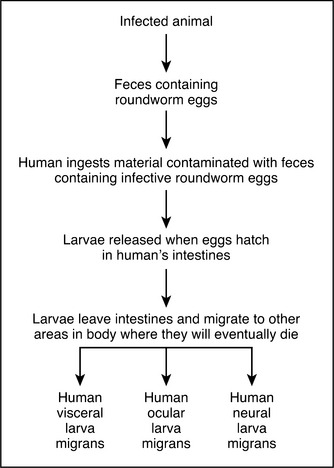ROUNDWORMS
Roundworms belong to the phylum Nematoda, which contains worms that are round and unsegmented. Members of this phylum are called nematodes. There are thousands of genera of nematodes, but only five are of zoonotic importance in North America: Toxocara canis, T. cati, Baylisascaris procyonis, Ancylostoma braziliense, and Trichinella spp. A. braziliense is a nematode parasite that is discussed under Hookworms. Trichinella spp. are discussed under trichinosis.
TRANSMISSION
After ingestion the eggs hatch, and the larvae are released into the intestinal tract. They burrow through the intestinal wall and into a blood vessel, where they are then carried on a circuitous journey through the host’s body. Eventually they end up back in the host’s intestines when they are ready to become adults. The cycle begins again after the adult female roundworms produce eggs, which are then passed in the host’s feces (Figure 31).
LARVA MIGRANS IN HUMANS
When people swallow roundworm eggs, they can develop diseases known as visceral larval migrans, ocular larva migrans, or neural larva migrans (Figure 32). As with animals, most of the damage seen with T. canis, T. cati, or B. procyonis infection in people occurs in young children. Most infections happen when children play in areas contaminated with infective roundworm eggs. Children like to put interesting things in their mouths, including dirt, dirty toys, or dirty hands, all of which may have been contaminated with infective roundworm eggs. The eggs hatch as usual in the intestine, and the released larvae burrow through the intestine wall into the blood stream, which carries them to various parts of the body, depositing them in tissues. The larvae can remain alive for many weeks in the tissues, where they migrate around causing tissue damage and destruction. This is known as visceral larva migrans (VLM). The tissues most often affected are the liver, lungs, eye, and brain. The damage caused by the migrating larvae is permanent and can result in severe visual, respiratory, or neurological conditions. The degree of damage or destruction is dependent on the number of larvae meandering through the tissue. Eventually the larvae die, and small abscesses or granulomas may form around them. In people, the larvae never fully mature.
Stay updated, free articles. Join our Telegram channel

Full access? Get Clinical Tree



